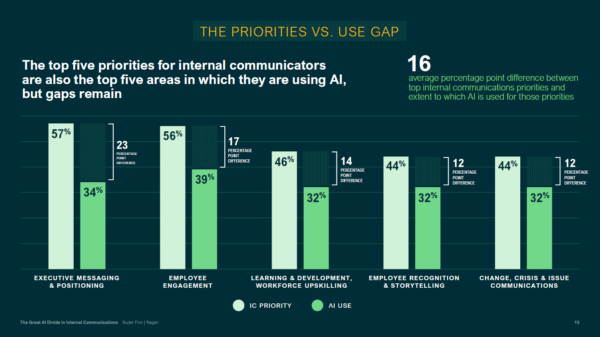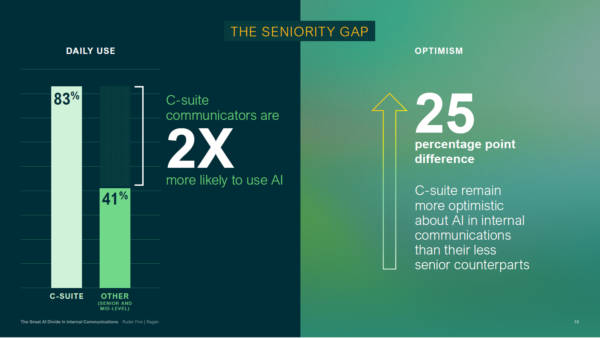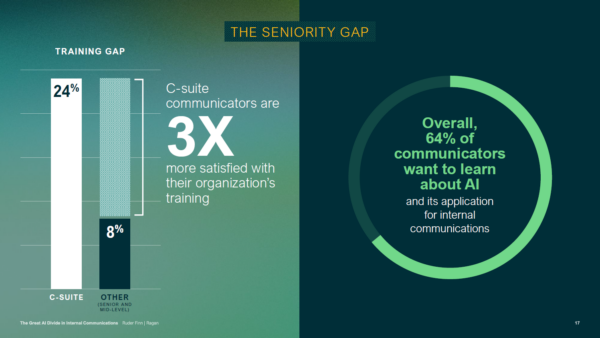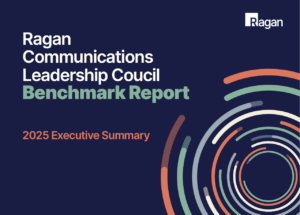Closing the AI gap in internal communications
Ruder Finn and Ragan’s study, “The Great AI Divide in Internal Communications” identifies an AI implementation gap between priorities and adoption rates.

This past spring, Ragan partnered with Ruder Finn’s internal communications arm, rf.engage to learn how communicators implement AI to advance their internal communications work in the future.
Ruder Finn and Ragan’s “The Great Divide in Internal Communications” report surveyed communicators in North America and the U.K. across all levels of seniority and a vast range of industries. The results identify clear gaps between how AI is perceived and its application to internal comms efforts.
“Change of this magnitude is not straightforward, so it’s no surprise that gaps are appearing as organizations come to grips with how these technologies can deliver transformational benefits,” said Ruder Finn CEO Kathy Blooomgarden. “The key to success is to remember that any business solution must bring people along, underpinned by communications, and be linked directly to thoughtful integration within existing ways of working.”
Hearing the AI triumphs and challenges in the Ragan community has taught us that the opportunities to become AI champions are vast—opening new pathways for communicators to serve as strategic advisors who mitigate risk by crafting governance policies and setting guidelines, holding up the communications potential of this tech to spread the influence of comms across the business.
A closer look at the largest gaps reveals where, and how, comms can secure that influence.
Understanding the gap between priorities and usage
Ragan and Ruder Finn’s research found that communicators recognize AI’s potential but lag in implementing it. On average, the report found a 16% difference between top internal comms priorities and the extent to which AI is used for those priorities.

While 57% surveyed consider executive messaging and positioning a top priority, just 34% are using AI tools to streamline their exec comms. Communicators can train a secure generative AI tool like ChatGPT4 to write in the style of their executives by providing examples of past messages, describing attributes of the executive’s voice such as tone, formality and sentence structure, and even spelling out words, phrases and language to avoid. Vetting any drafts with relevant stakeholders, including the executive team and counsel, will inspire further confidence to scale this process and close the gap.
As exec comms is an underutilized AI use case, overcommunicating the drafting and editing processes also builds trust between comms and senior leaders to remind them of the human element and EQ required for the messages to resonate.
Similarly, 56% of communicators consider employee engagement a top priority, but only 39% use AI to assist with employee engagement. While that implementation rate is slightly higher than with executive communications, a 17% gap still exists.
A genAI tool can also help draft internal newsletters, memos and announcements consistent in an agreed-upon brand voice. This can even be harnessed to personalize onboarding materials for new employees that tailor key information about policies and values to each hire’s specific role.
AI-powered sentiment analysis tools, meanwhile, can interpret open-ended pulse survey answers or social sentiment from intranet posts, analyzing the language to craft a summary of how employees feel about a new change or initiative.
Whether comms sit under the HR function or not, championing these use cases positions with an early adopter mindset positions communications in an advisory capacity that strengthens trust to close the gap.
Of course, this is contingent on effective training around each new AI tool and use case. A closer look at adoption level by seniority can inform your approach to scaling training.
Seniority adoption gaps underscore training opportunities
The research found that C-suite communicators are twice as likely to use AI than less senior internal communicators — 83% of C-suiters surveyed said they use AI daily, compared with 41% of senior and mid-level respondents.

C-suiters were also 25% more optimistic about AI in internal comms than their less senior counterparts.
This cohort is not a monolith. Segmenting the C-suite by age found that 100% of C-suiters 43 and under use AI daily compared to just 58% of C-suiters age 44 and over.
These discrepancies in daily use and optimism can be solved with training. How’s that going so far?
While around half (53%) of C-suiters aged 43 and under said they were satisfied with the AI training they received compared with 42% of C-suiters aged 44 and over, a much wider training gap exists between the C-suiters surveyed and other communicators.
Just under a quarter (24%) of C-suiters said they were satisfied with their organization’s training, while the number of satisfied senior and mid-level comms pros was just 8%. Concerning as those numbers are, the dissatisfaction shouldn’t be mistaken for disengagement — 64% of communicators across all seniority levels said they want to learn more about AI’s applications for internal communications.

Putting this all together, we’re looking at a C-suite sample that’s more comfortable using AI for internal communications tasks, and happier with the training being offered, than others who sit in the function.
Considered alongside the paltry level of training satisfaction across the board, this makes sense — those who don’t consider their level of training to be sufficient are less willing to dive in.
While demonstrating comfort with ambiguity is a valuable leadership competency, the risk management remit of internal comms pros, coupled with the myriad reports on what happens when AI implementation scales irresponsibly, may explain the gap between a desire for training and satisfaction with the training received.
This begs the question of how specific and detailed the AI training is that communicators receive. Are you surveying your team to address the root causes and concerns driving apprehension?
While most training includes a focus on human-centered prompt creation using generative AI tools to draft executive messages and employee engagement content, your training can also go much further to explore things like:
- Launching and sustaining an effective cross-departmental AI task force.
- Shaping AI governance and crafting internal guidelines for cross-functional use cases that prioritize transparency and security amid the latest regulatory developments.
- Streamlining employee experience comms around recruitment, engagement analytics and the intranet.
- Building a blueprint for successful AI implementation that aligns communicators on each step, from committees to execution.
These insights are a reminder that comfort levels and competence are not one and the same. The most effective upskilling programs are personalized to each employee’s role and preferred style of learning.
Learning those preferences from the outset, and then training your communications function in kind, will ensure that they are empowered and equipped to bring the rest of your workforce along the adoption curve.
For more on the internal comms AI gaps among various industries and company sizes, check out the full report here.
Ruder Finn will unpack the results during Ragan’s Internal Communications Conference, Oct. 16-18 at Microsoft HQ in Seattle, WA. Register now!







